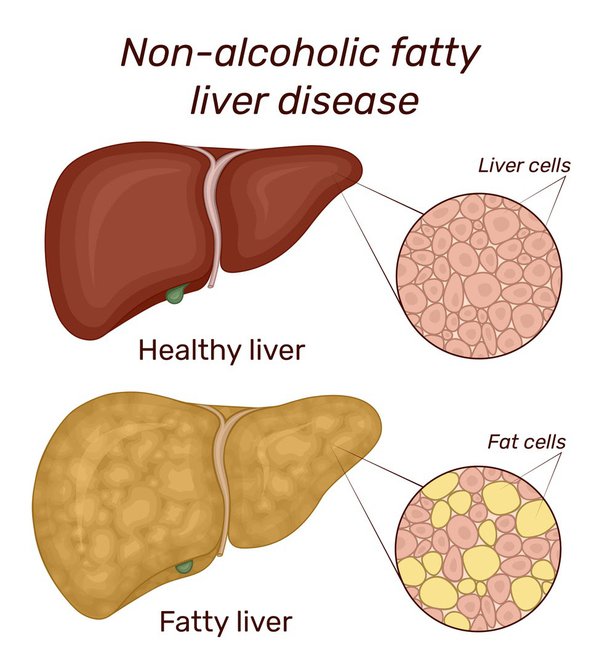
The main aim for writing this blog is to bring awareness to the public about fatty liver disease
and the new treatment options available to treat the condition.
This article is especially aimed to reach individuals who suffer from fatty liver disease. This is
our newest hope to defeat fatty liver disease which affects about 30% of the US population
What is Fatty Liver disease ? How does this affect a healthy liver ?
As the name suggests, it is a condition in which the liver has more fat cells than the normal
healthy liver. Imagine a liver being made of red small marbles (liver cells), and tennis balls (fat
cells). In fatty liver these fat cells start to get bigger and their number increases. The fat cells
then start pressing on the liver cells and start taking their place. This leads to destruction of the
healthy liver cells. The space is taken over by unhealthy large fat cells and fibrous tissues. Over
years and decades this process continues to cause damage to the liver.The fat cells in liver are
unhealthy and do not perform the function of liver cells. Liver cells have multiple functions like
detoxification, making protein, clear blood and many others. When the fat cells take over the
liver, all these functions are affected. Hence the liver becomes fatty and fibrous, and does not
function.
Does everyone with Fatty Liver develop liver damage ? What is the difference between
NAFLD and NASH ?
Not all the people with fatty liver develop liver damage. In most people even when the liver has
excessive fat the damage is not significant. The liver and fat cells liver in harmony. In these
patients, the liver enzymes are normal and no inflammation is noted on liver biopsy. This is
called Non Alcoholic Fatty Liver Disease. In a small percentage of people when the fat cells lead
to irritation and destruction it is called NASH. The more severe form of NAFLD is called
nonalcoholic steatohepatitis (NASH). Over a period of 20 or more years these people are prone
to develop cirrhosis.
How to treat Fatty liver disease (NAFLD or NASH) ?
The mainstay of therapy has been to lose weight, which decreases total fat in the body, and in
the liver. Studies have shown people who underwent weight loss surgery with underlying fatty
liver can lead to reversible liver damage. It prevents progression and worsening of liver disease.
It also leads to healing of the liver. This has been confirmed with multiple studies and with liver
biopsy. Various ongoing studies are undergoing to halt progression of liver disease in fatty liver.
However no specific medications are yet available. Some studies have shown benefit with
Vitamin E therapy. There is no doubt that limiting calorie intake is the easiest and the best way.
Personally, I starve every day. My average calorie intake is usually less than 1500. I have had 2
meals a day for the last 3 years. This is only helping me to keep my weight stable. I have not
lost weight with this strategy. Hence if I were to lose, I would have to do rigorous exercise.
Before I started medical college, I had gained about 40 lbs and it was a struggle to lose weight.
So I can relate with individuals who carry those extra pounds. As most of you know, it is not
easy to curb appetite and desire to eat.
If I cannot starve or diet every day, what other options do I have to lose weight ?
Proven, but expensive and drastic option is to go for weight loss surgery. It works most of the
time. It is best suited for people with BMI above 35. Two best surgical options are vertical band
gastroplasty (VBG) or Roux-en Y gastric bypass (RYGB).
I have a BMI above 27, and want to lose weight. What is the best option for me ?
Recently available, and life changing for a lot of people is the launch of GLP-1 medications.
These medications are revolutionizing weight loss. The recent GLP-1 medications –
Semaglutide (Ozempic) and Mounzaro (Tirzepatide) lead to 10-15% weight loss in people. They
were initially launched to treat diabetes, but now are being extensively prescribed for weight
loss.
How do GLP-1 (Semagltuide, Tirzepatide) work ?
GLP-1 (glucagon-like peptide-1) medications are a class of drugs used in the treatment of type
2 diabetes mellitus. They work by mimicking the action of the GLP-1 hormone, which is naturally
produced in the body in response to food intake. GLP-1 helps regulate blood sugar levels by
increasing insulin secretion and reducing glucagon production, which leads to decreased
glucose production in the liver and increased glucose uptake in the muscles. These medications
also work by reducing gastric motility, hence people feel full with less calorie intake which
assists in controlling blood sugar and aid weight loss.
How can I get GLP-1 medications ?
The easiest and cost effective way is to have your PCP write a prescription so that the
insurance will cover the cost. However, in reality this might be not the easiest way, since
insurance coverage is not always good. As a weight loss clinic, we prescribe our patients the
medications through compounding pharmacies, The medication can be shipped to your home.
As a license prescriber in Texas I can prescribe the medication to any individual in the State of
Texas. You can visit the website to start the process. All the steps are Online, and virtual.
We are looking forward to being part of your Weight Loss Journey.